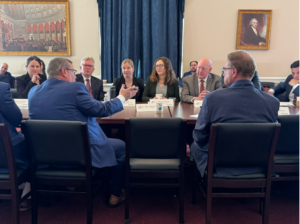August 30, 2022
—
This summer Congress passed the Inflation Reduction Act. While many of the law’s programs will serve a range of needs, the law will make billions available for communities to build resilience — including adapting to rising seas, stronger storms, and more frequent flooding.
Specifically, the Inflation Reduction Act offers new opportunities for smarter, more proactive approaches to flood resilience. The law will help strengthen federal weather forecasting and data, increase investment in resilience programs, and target technical assistance within underserved communities.
The Inflation Reduction Act comes nearly a year after the Infrastructure Investment and Jobs Act, which also provides billions of dollars in funding for resilience. Read on to learn how the Inflation Reduction Act complements last year’s bipartisan infrastructure law and how it can strengthen flood resilience across the country.
What’s in the law?
Though the Inflation Reduction Act touches a range of federal programs and policies, we’ll be focusing specifically on how the law can enhance flood resilience.
First, the package will enhance federal data and modeling capabilities. Project builders and planners need accurate data to design and construct flood-resilient infrastructure. Without such data, infrastructure may be unfit to withstand a future of rising seas and more frequent storms. To help meet the need for complete, accurate, and forward-looking data, the bill will invest across the following programs:

- Weather Computing Capacity: $190 million for NOAA to secure additional high-performance computing, data processing capacity, data management, and storage.
- Research and Weather Forecasting: $150 million to the National Oceanic and Atmospheric Administration (NOAA) to accelerate advances and improvements in research, observation, modeling, and forecasting, as well as communicating this information to the public. Funds will focus on ocean and atmospheric processes related to weather, coasts, oceans, and climate.
- Council on Environmental Quality (CEQ) Environmental and Climate Data Collection: $32.5 million to support the CEQ data collection about extreme weather impacts, including ensuring such data is accessible to communities.
Second, the law boosts funding across an array of federal programs, providing resources that complement the Infrastructure Investment and Jobs Act’s historic investments in flood resilience.
The following programs include proactive flood resilience projects as an eligible purpose:

- NOAA Coastal Resilience Grants: $2.6 billion for grants that support the conservation, restoration, and protection of coastal and marine habitats and resources to enable coastal communities to prepare for extreme storms.
- Environmental and Climate Justice Block Grants: $3 billion for the Environmental Protection Agency to award grants that benefit disadvantaged communities, including for flood resilience and adaptation projects, technical assistance to support such projects, and for stakeholder engagement, among other purposes.
Third, the bill targets investments in technical assistance to help build local capacity to advance projects. The law intends to benefit small, rural, and underserved communities through the following programs:

- Neighborhood Access and Equity Grants: $3.2 billion total for a Department of Transportation grant program to advance projects that reduce or manage stormwater run-off, employ natural infrastructure, or offer other benefits. Funding may also support pre-development work — those critical steps that must take place before a project can begin — as well as planning and capacity building for economically disadvantaged, underserved communities.
- Tribal Climate Resilience: $220 million to the Bureau of Indian Affairs for tribal climate resilience and adaptation programs.
- Federal Capacity: $20 million to enhance NOAA project review efficiency and effectiveness, technical services and equipment, and agency efforts to transparency, accountability, and public engagement.
Building for the future
With so many communities grappling with the impacts of flooding, AFC is heartened that the Inflation Reduction Act provides billions in additional funding to adapt to these challenges. Combined with the bipartisan infrastructure law, this new package establishes an even broader suite of programs that can help prepare for and respond to flooding.
We look forward to working with federal agencies, Congress, and AFC’s members and partners to ensure these programs deliver on a more resilient, equitable future. To learn more about opportunities from the Inflation Reduction Act, subscribe to our monthly newsletter. And for more about federal funding opportunities for your community, visit our Flood Funding Finder.
—
Featured image at top: Jeff Horne/Flickr






